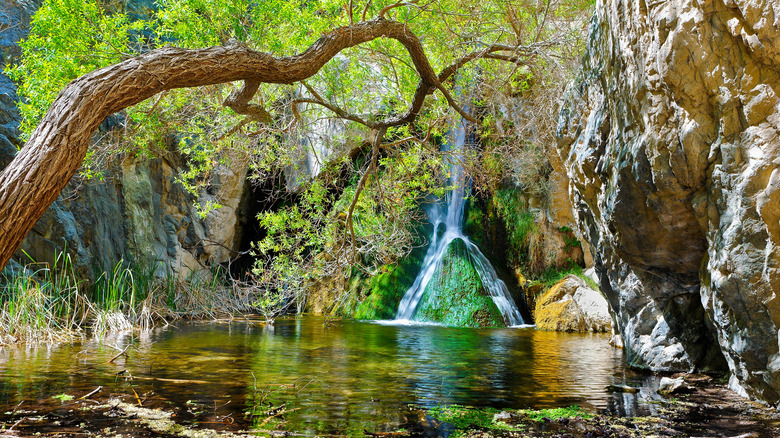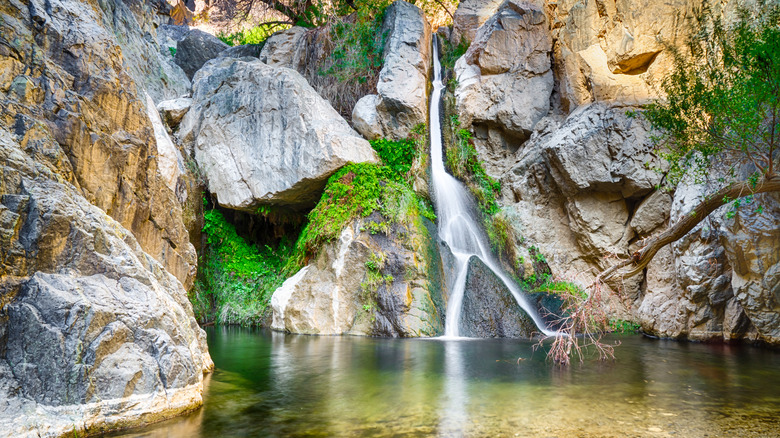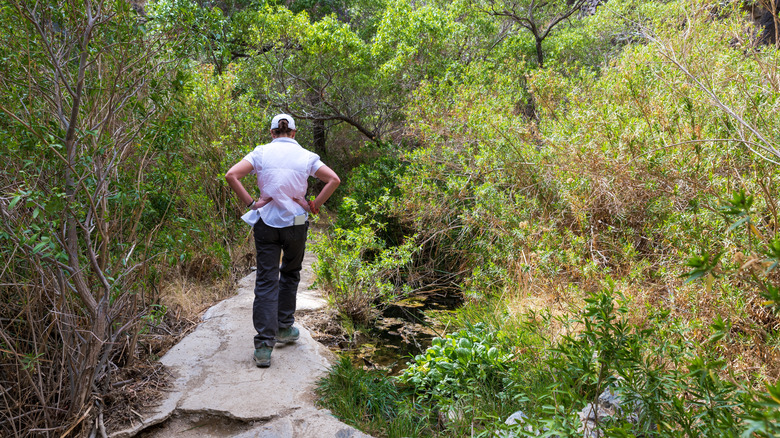One Of Death Valley's Few Year-Round Waterfalls Is A Secret Oasis Brimming With Ferns And Frogs
We may receive a commission on purchases made from links.
When you think of Death Valley, California, images of harsh, arid landscapes and weather-eroded canyons often come to mind. However, this desolate piece of the Mojave Desert is also home to a lush oasis that brings life to the region's barren lands. Hidden in the isolated western part of Death Valley National Park lies Darwin Falls, one of the only year-round waterfalls in the region.
It's hard to imagine that a waterfall could play any role in the unforgiving badlands environment. Yet, as you follow the 7-mile out-and-back route to the falls, the gently trickling creek and tufts of foliage hint at this oasis to come. Once you make your way through the final stretch, scrambling between narrow canyon walls and over large rocks, Darwin Falls appears in all its glory. Fed by a natural spring, the 20-foot waterfall tumbles into a shallow pool in a boulder-lined canyon. Dragonflies zoom overhead, while frogs find shade beneath the cattails, ferns, and trees that depend on the spring for water.
Although the trail is mostly unmarked and unshaded, the path follows a washed-out road and then a canyon, so it's hard to get lost. To be on the safe side, though, download a trail app and enable its offline mode before starting your adventure. There is no cell reception, but iPhone's SOS alert does function in this area. Anticipate spending between 2.5 to 5 hours hiking and notify someone of your plans in case you have an accident.
Things to know before hiking to Darwin Falls
Death Valley is the one national park you may want to avoid visiting in the summer for your own safety. Between May and September, temperatures here can reach over 120 degrees Fahrenheit, making hiking during the heat of the day a deadly activity. If you find yourself at the Darwin Falls Trailhead after 10 a.m. during this time of the year, pack in your hiking gear and return another day. The best time to visit is between October and November, when temperatures range between 70 and 90 degrees, and during the early spring months (March and April), when the temperature is in the 65 to 85 degree range. The path to Darwin Falls isn't one of the US national park trails intended for experienced hikers, but it is challenging, so we recommend hiking with a partner.
Although the waters look inviting, swimming or entering the falls is illegal. The spring not only provides drinking water for nearby Panamint Springs Resort but is also a delicate microenvironment that desert animals, including bighorn sheep, rely on for water. For this reason, pets are not allowed on the trail, and they can't be left in your vehicle due to the area's extreme temperatures.
There are no restrooms at the falls or by the trailhead, so plan accordingly when you visit. Hikers are reminded not to leave toilet paper (or other litter) and to avoid going to the bathroom near the springs. Consider packing a ziplock bag for used toilet paper, a sweat-proof sunscreen like Banana Boat's Ultra Sport Sunscreen SPF 50+, plenty of water, a snack, and a hat.
How to get to Darwin Falls
Getting to the Darwin Falls Trailhead takes some work, but it's worth the effort. The nearest major airport is Meadows Field Airport (BFL) in Bakersfield, 187 miles from the falls, so you'll need to rent a car. The falls are located a little over an hour from the Furnace Creek Visitor Center and other heavily trafficked parts of the park, including Death Valley's top sunset-watching destination. In 2023, a flood washed out the dirt road to the original trailhead. Now, visitors must park off of CA-190 and hike 2.4 miles each way along Old Toll Road; this is why the trail runs 7 miles instead of only two.
Enter the coordinates for Old Toll Road into your GPS and look for a large pile of dirt blocking off the road. You can park on the shoulder of CA-190, but make sure your vehicle isn't blocking traffic. After following Old Toll Road for about two and a half miles, you'll come across the original Darwin Falls Trailhead, which is the only place marked with a sign. During this part of the hike, you'll start to see hints of life, including small trees and bushes.
Although the trail has a gradual incline, the last quarter mile is rocky. Take this part slow, and be extra careful when climbing over wet stones or slippery boulders at the falls. You'll find shade-giving trees lining the creek, so take a rest and rehydrate before returning to Old Toll Road and heading home.


